Washington Street — © Brian Rose
It was the winter of 1985, and I was casting about for something new to photograph. I had completed projects on the Lower East Side and Central Park, and later that summer I would begin shooting the Iron Curtain and the Berlin Wall, a project that would continue to occupy me up to the present. For reasons I cannot recall, I walked over to the west side with my camera and spent several days photographing the meatpacking district. I began from the West Village, the scene above relatively unchanged today. The yellow and black sign warning illegal parkers that the air will be let out of their tires remains attached to the wall of the building almost 28 years later. In 1985, David Dinkins was running for Borough President–he would later become mayor.
Washington and Gansevoort Street — © Brian Rose
In the morning the meat packing district was a vast open air scene of carnage. Sides of beef were hung from hooks that slid along overhead conveyors. Men in bloodied white coveralls grappled with the carcasses. By mid morning the hubbub of the city’s meat market subsided and the cobblestone streets took on a look of abandonment, astonishing in the heart of such a great metropolis. As evening approached another kind of meat market took over–this one human trade–as prostitutes prowled the empty streets, many of them transvestites, overly tall females tottering about on high heels, while men in black leather sought the anonymous doors of sex clubs.
Gansevoort Street — © Brian Rose
In 1985 a restaurant called Florent opened on Gansevoort Street. For years it was a late night destination for the downtown social set, gay and straight alike. It was hard to find, and took a certain fortitude to navigate the urban hell/paradise surrounding it. It was not expensive, but for me, blowing all my money on 4×5 film, on a whole other plane of existence. You can see it on the left, the glowing neon florent in the window. A website with the sign still glows on the Internet here. A recent article about the former owner Florent Morellet is here.
Washington and Little West 12th Street — © Brian Rose
If you look up some of the business names, you see that many still exist, like J.A.W.D. above, operating out of the Hunt’s Point market in the Bronx. That’s where most of the distribution of meat, fish, and produce is handled for New York in modern refrigerated facilities. The red door to the left of the truck was the entrance to the Mineshaft, probably the most infamous of the men’s sex clubs that dotted the meatpacking district. It was closed later in the fall of 1985 at the height of the AIDS crisis.
Washington Street — © Brian Rose
The entrance to the Mineshaft in the winter of 1985.
Little West 12th Street — © Brian Rose
In 1985 the high line was a nameless unused rail viaduct that ran down the west side of Manhattan all the way into the West Village. It cast ominous shadows over streets and vacant lots. The elevated rail line once served the docks and factories lining the Hudson River. It replaced the tracks that ran down the middle of Tenth Avenue–Death Avenue it was called back then. The picture above was taken where the beer garden of the Standard Hotel now is.
Washington and West 13 Street — © Brian Rose
The desolation of the meatpacking district by day was profound, but many parts of lower Manhattan were also quite empty. Things were changing, however, and the Soho gallery scene was already well established, and Tribeca was beginning to take off. Nevertheless, in the winter of 1985, the meatpacking district slumbered undisturbed through the daylight hours.
Washington and West 13th Street — © Brian Rose
Just as in the loft neighborhoods further downtown, there were artists living and working above the meat market below. A telltale sign were the gas heating units that looked similar to window air conditioners. If you didn’t have much money you only ran these for part of the day, and I remember visiting some pretty cold lofts in those days. The other thing that made the meatpacking district less attractive for living was the stench of the meat businesses–it permeated everything.
West 14th, Hudson, and Ninth Avenue — © Brian Rose
Ninth Avenue — © Brian Rose
The parking lot above is the present location of the Hotel Gansevoort.
West 14th Street — © Brian Rose
The “apple” store on 14th Street.
West Street and Tenth Avenue — © Brian Rose
The Liberty Inn shared its odd shaped building with the Anvil, another of the neighborhoods sex clubs. The Anvil is long gone, but the Liberty lives on as a rent-by-the hour hotel.
Tenth Avenue and West 17th Street — © Brian Rose
So much has changed in the meatpacking district and the adjoining gallery area of Chelsea that I hesitate saying anything at all. What was once urban desolation is now the epicenter of fashion and art in the western hemisphere. The High Line is no longer a rusting hulk, but… I’ll let you fill in the blank. I love it–it’s a perfect conjuncture of preservation and contemporary architecture. I hate it–it’s too crowded much of the time to be enjoyed. But what can you do? This is New York. You cannot live here if you cannot abide change.
Even as the money sloshes through the streets of the meatpacking district, we are reminded of our fragile hold on this island as the waters of Hurricane Sandy flooded the couture shops and art galleries along the Hudson. Our ultimate fate may yet be determined by the melting ice of Greenland.
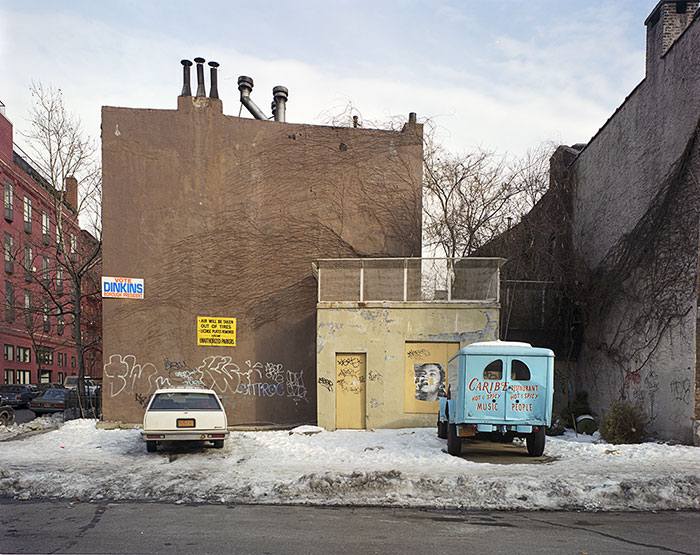
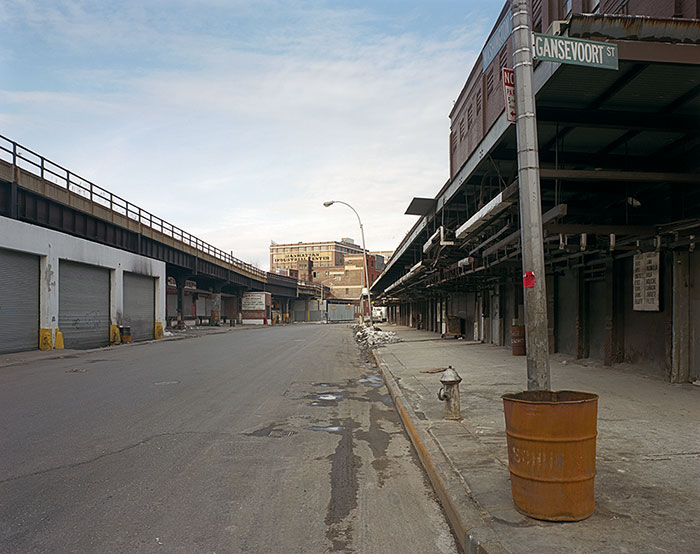
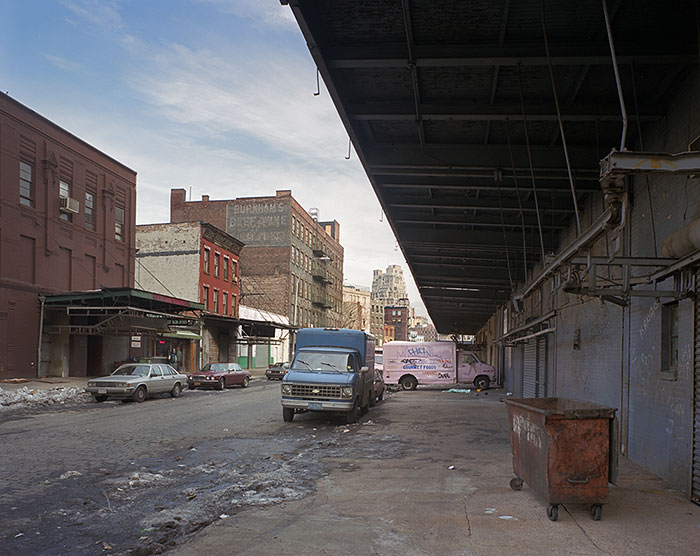
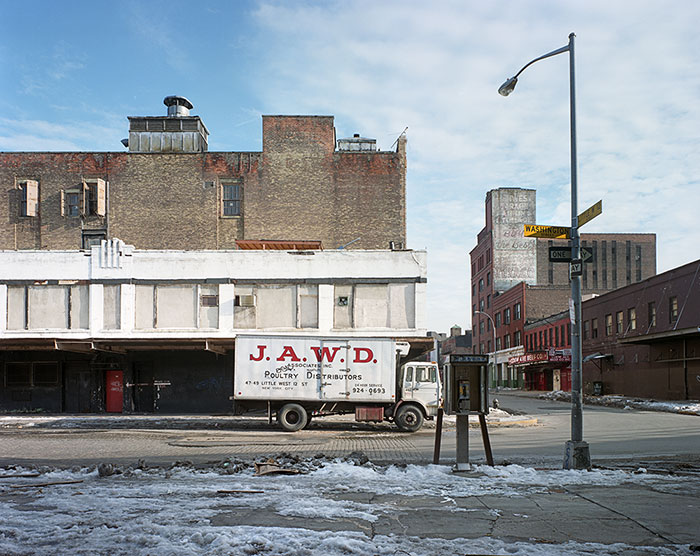
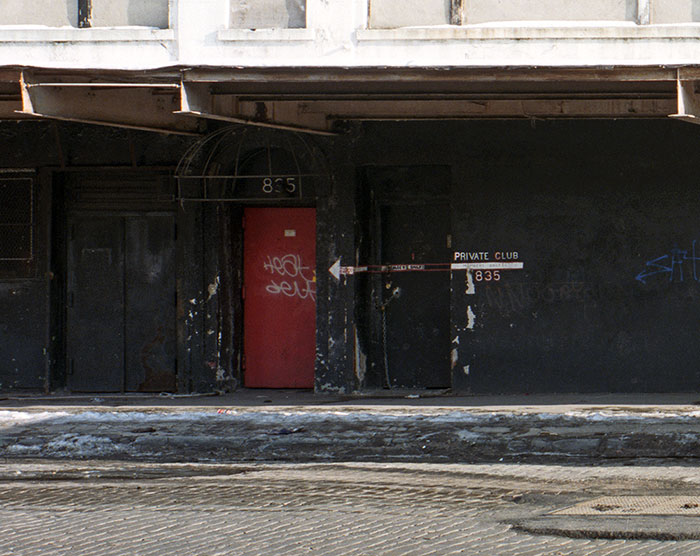
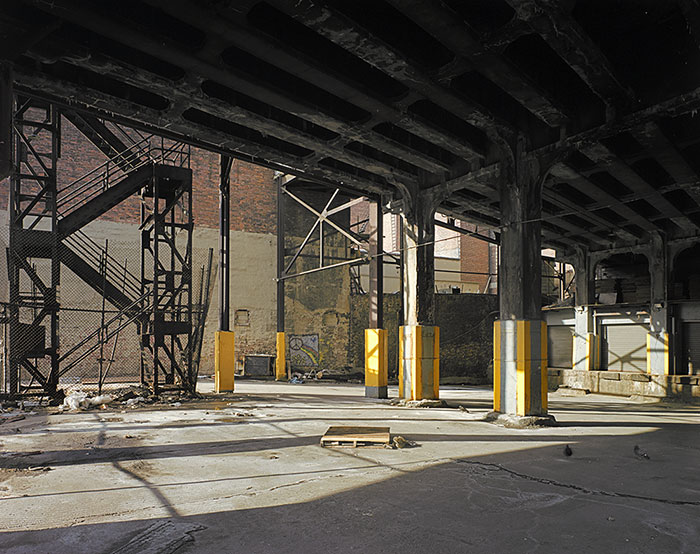
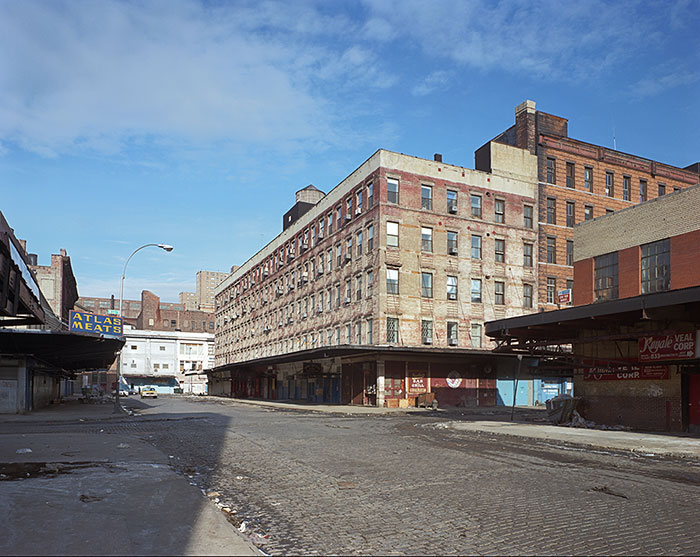
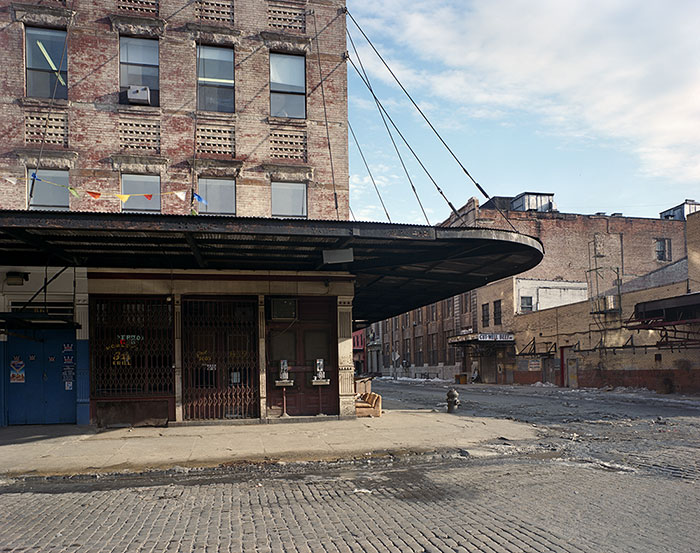
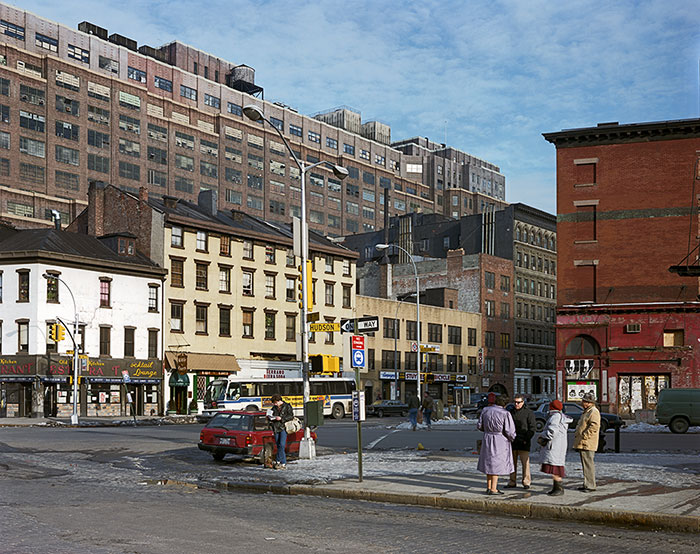
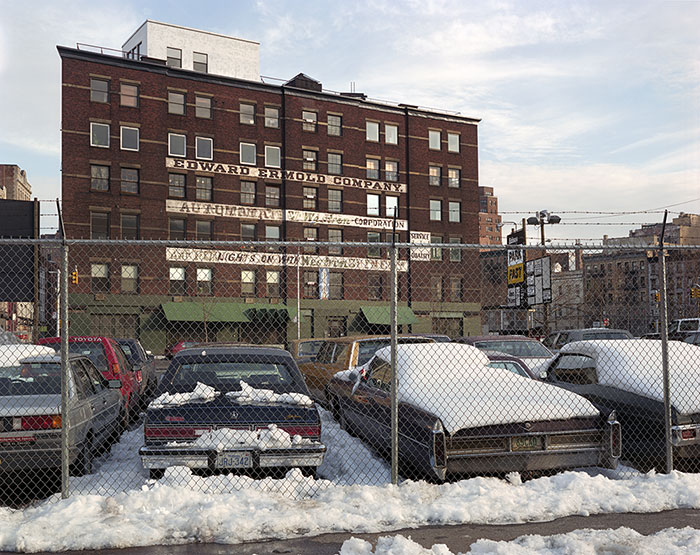
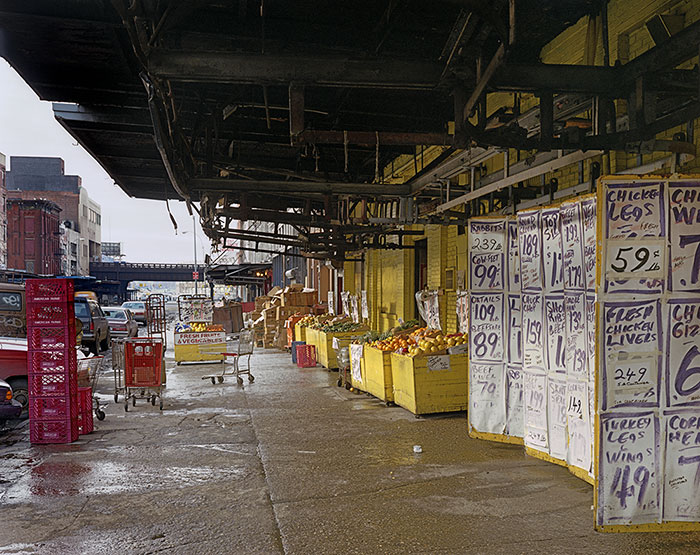
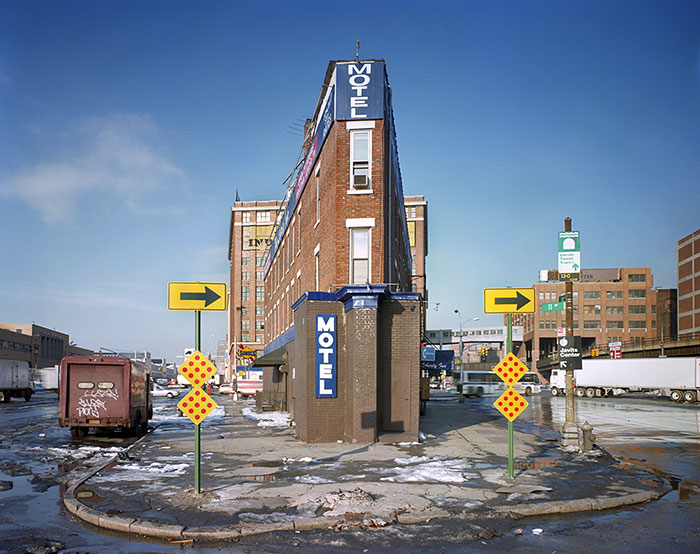
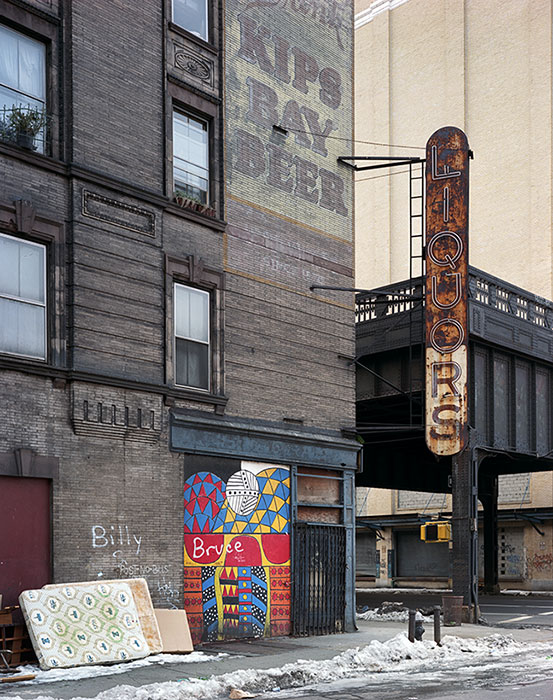
Wonderful trip down memory lane. Thank you for fabulous pictures. I’m feeling sad about how much time has passed.
Even the snow on the streets looks like it’s from a different era in these global warming Decembers.
Thanks for sharing these! One observation is that the graffiti looks exactly the same. Also in my memory Im used to seeing sides of beef hung on the streets. Do you have any pix of that? I definitely miss the old days, but you didnt fuck around in this area after dark unless you wanted something bad to happen to you. Now about the only bad thing that happens down there is the shopping!
#38 is great — closed-down liquor store is currently Comme des Garcons. Too bad that ghost sign got blasted off the wall — I wonder if Frank Jump got a chance to document it first.
I love that last shot. I am drawn to things like this. i shot a former clothing store (I think) in D.C. near the convention center and bunches of old hotels and movie theatres in L.A.’s skid row.
I love these photographs. After seeing these pictures I immediately decided to watch the photos I made in NY last year. And I also used Google Earth to see the changes over the years.
If you have more than these pictures of the Meatpacking District it almost calls for a book like you made about LES.
By the way, do you know if Time and Space is available in The Netherlands?
Thank you so much for this treat. I moved to NYC in 1986 and this is exactly what one could see strolling in that specific small area from West 14th Street/Gansevoort and from 9th Ave to the Piers.
It was the most decadant yet romantic area of the City. The “Wild Wild West”.
The Elevated Highway, the crumbling piers…
I wish you’d publish these pictures in a book that many of us who worship New York will very much enjoy! Just beautiful.
Great photos. I also lived there during that period, attending SVA. I wandered around quite a bit with my cameras too, but 35mm. One detective I knew was on the job with his partner in the meat packing district and pulled over a trolling limo. It had Eddy Murphy in the back seat, “looking for an address”.
I believe the last photo is actually 16th Street. The Northeast corner of 17th was for many years, a soul food restaurant called West Boondock, now Artichoke Basil. I lived on that block for 5 years in the Fulton Houses project, one of the first tenants when it opened in 1965. A 2 bedroom apartment on the 21st floor with a sweeping view of the Hudson was $76mo. including utilities. One rarely ventured west of 9th Avenue in those days.
Thanks, for the marvelous photos! Brought back memories.
Terrific shots. I too have lived in the Village and well before I was fortunate enough to get a slot at Westbeth. I recall the clanking at the Highline rail when they had to run a train a year to keep their option; the whistles of the tug boats bringing rail car barges to the rail piers at “Hudson Yards” with whatever they carried and the ongoing action of the freighters docked all along the piers with trucking in and out of them.The neighborhood was so busy and crowded with dock workers at midnight that the Deli’s were open 24/7.
Jack Dowling
Wow. I had an art studio in the building at 430 W 14 from 1984-86, pictured above from 13th and Washington. Brings back some serious memories. We used to look out the window late at night at the meat market workers in their bloody smocks, and at the tranny hookers servicing them and the various Hasidim, cops, and tough guys who drove around looking to get off.
From our roof in summer we could also see the rooftop sex at the Mine Shaft.
New York at that time was a very contradictory place but it was truly the creative capital. I have moved a number of times through other cities over the years but that time and place remains the most remarkable experience of my life.
I lived north in Hells Kitchen and loved to wander the city at night in a haze of lonliness and sadness…(ahh such was the life of a young mooody man in the city). I always gravitated to the Meat Packing district. Its stew of sex, gore and cobblestone gave me a certain comfort. Florents was the only light on after all the butchers went home and the sex boys went underground. Later on when I grew older and less wise–I was underground too and missed out on the slow choke of commercialization of the district. Your photo essay reminded me of that time in which I was still mesmerized by the city.
Love, love love the pictures….I moved from London to the village in the late 80s, and lived on the corner of Horatio & West Side Highway, I lived there when the meatpacking district was real….just like your amazing images, not full of fluffy designer shops….but hey ho that regeneration for you!
Early mornings and late nights, I was more afraid of running into a New York rat hustling for scraps, than the working girls and characters of the MPD…
Thankyou for sharing your images, they revoked fabulous memories:-)))…. Of those wild and crazy yesteryear s ….
Chase…:-)
Love, love love the pictures….I moved from London to the village in the late 80s, and lived on the corner of Horatio & West Side Highway, I lived there when the meatpacking district was real….just like your amazing images, not full of fluffy designer shops….but hey ho that is regeneration for you!
Early mornings and late nights, I was more afraid of running into a New York rat hustling for scraps, than the working girls and characters of the MPD…
Thankyou for sharing your images, they revoked fabulous memories:-)))…. Of those wild and crazy yesteryear s ….
Chase…:-)
Hope to be out there with my view camera this week to do some before/afters. Stay tuned for pictures.
Are there any vestiges of the Meatpacking District as it used to be still present? Any rundown buildings left? Any of the grittiness, even a small corner of it? I wrote a crime novel using that as a backdrop for my climactic scene and it’s going to be published next year but- I’d really hate to relocate the slash and dash scene to Hunt;s Point.
good morning brian
thank you for the exquisite images of the meat packing district.
for many years i lived at 763 washington st and visited the mineshaft
the anvil the eagle and the spike…thank God i lived thru it all.
i would like to speak to you in the near future because a documentary
is being made about me and my 25 years in the music business as an
A&R executive (talent scout) and we are covering all grounds with some
bittersweet stories that include the sex clubs all along that wonderful
crazy strip of washington and west st.
all best
michael alago
Wow! This is great stuff. Love the photographs. I am a little to young to remember this part of NYC, but it is super cool to see what it looked like. My mom would take me and my brother shopping in the village every other weekend in the mid 80’s. We never ventured to the West Village for obvious reasons. I think she knew what the area was all about:). This is ethnography and history all rolled into one. Thank you for this!!
The book is on the way. The pictures from my blog and more. An opportunity to pre-order via a kick starter campaign coming soon. Exhibition in July.
Pingback: Excavating The Filthy History on John Waters’ ‘Bill’s Stroller’ | Filthy Dreams
I was a dancer at the Gaiety 1976 – 1978. While I was supposed to be in my StonyBrook dorm studying my Freshmen year, I was trolling and hoofing around Sin City as a naïve 18 year old. While I preferred underground black clubs (the Gallery, Paradise Garage, Sound Factory,…) I also relied on after hours drug clubs when I found myself without a place to stay while I danced in NYC on the weekends. The Anvil, Crisco Disco, Alex in Wonderland, CockRing, 12West, were places I could find comfort in the company of what I thought were the most attractive men in the world while I danced on my drugs. I wrote in detail about my experiences 1976 – 2004: ‘Homo GoGo Man’ by Christopher Duquette available on DonnaInk & Amazon. F**K High School! My years of clubbing in NYC were my golden years.
Thank you so much for posting these incredible photos and the messages of an era that I am proud to have taken part in. I moved to NYC on New Years eve 1984. I remember many places which brings back memories.